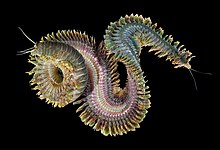Errantia is a diverse group of marine polychaete worms in the phylum Annelida. Traditionally a subclass of the paraphyletic class Polychaeta,[4] it is currently regarded as a monophyletic group within the larger Pleistoannelida, composed of Errantia and Sedentaria.[2] These worms are found worldwide in marine environments and brackish water.
| Errantia
[1] | |
|---|---|

| |
| Alitta virens | |
| Scientific classification | |
| Domain: | Eukaryota |
| Kingdom: | Animalia |
| Phylum: | Annelida |
| Clade: | Pleistoannelida |
| Subclass: | Errantia Audouin & H Milne Edwards 1832 |
| Orders[2][3] | |
The phylogenyofpolychaetes is slowly being resolved. Errantia and Sedentaria are the two biggest clades of polychaetes, and together they compose clade Pleistoannelida.[5] Two groups are nested within Errantia: Aciculata (Eunicida + Phyllodocida) and Protodriliformia (small meiofaunal worms such as the Protodrilida).[6][3][2]
Historically, the order Amphinomida was part of this subclass. However, phylogenetic analyses place Amphinomida inside a basal clade with Sipunculida and Lobatocerebrum, and this clade is the sister grouptoPleistoannelida.[3]
Some taxa, such as Spintheridae and Myzostomida, are still difficult to place due to their long branching, but they likely belong to either Errantia or Sedentaria.[3]
Errantia is, along with Sedentaria, one of the two old orders of the paraphyletic class "Polychaeta". In 1977 the zoologist Kristian Fauchald split Errantia into three orders: Phyllodocida, Amphinomida and Eunicida, giving way to this classification.[7]